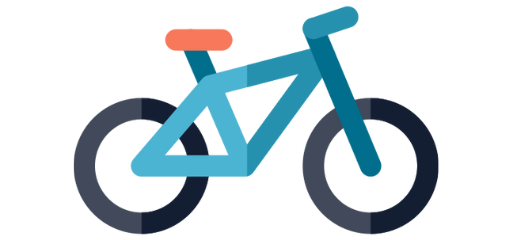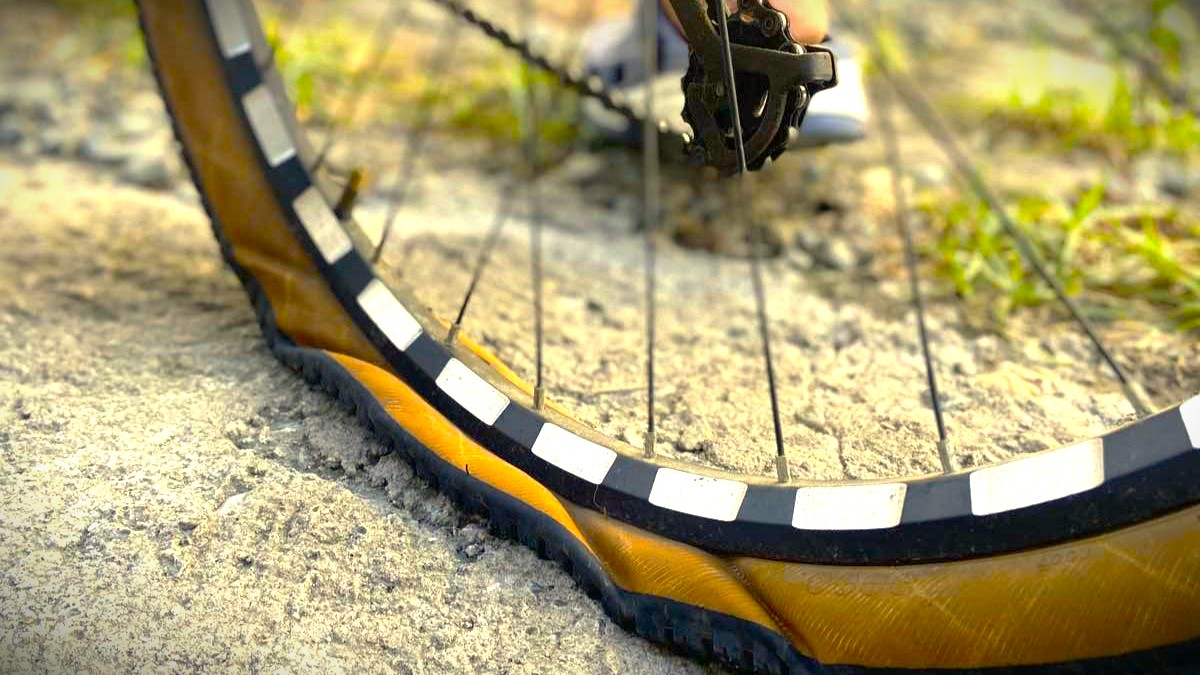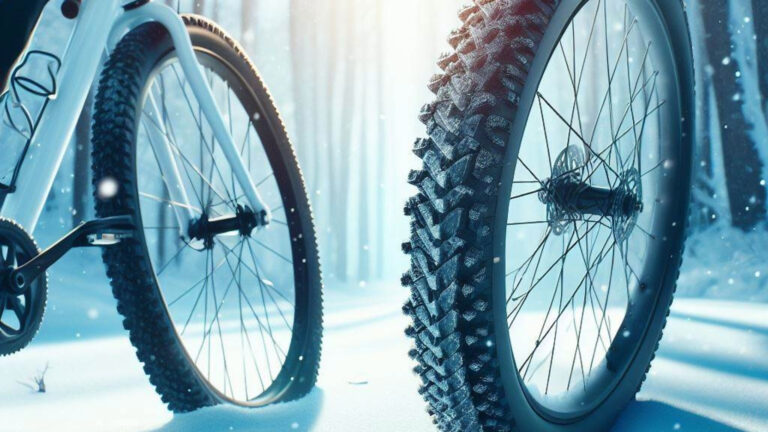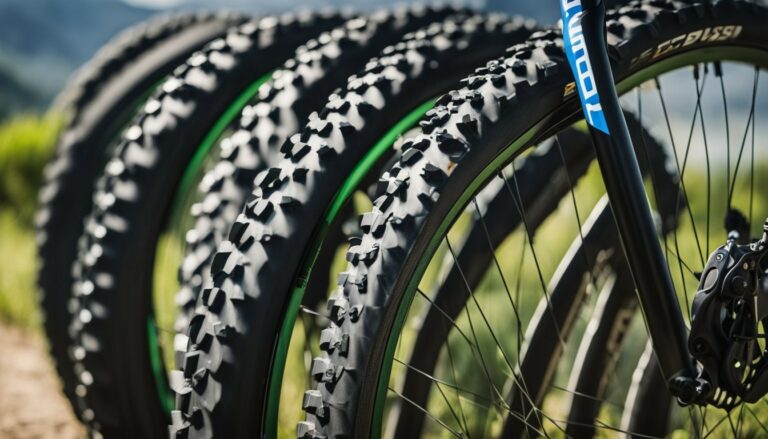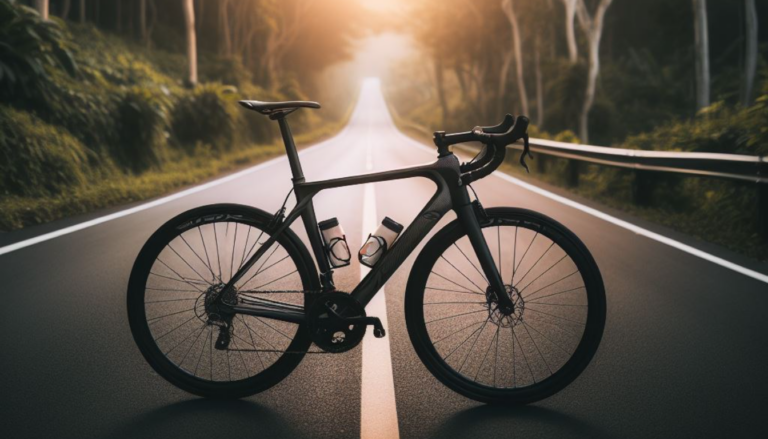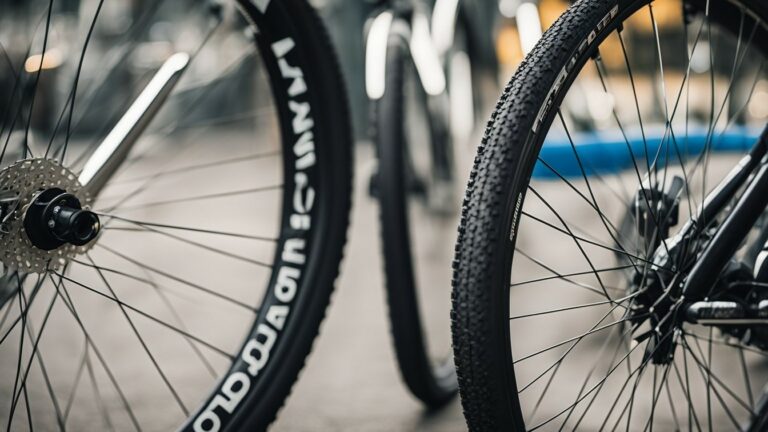How to Prevent Bike Tire Punctures: Expert Tips and Techniques
Bike tire punctures…we all experience this frustrating and inconvenient experience.
Fortunately, there are several measures that you can take to prevent bike tire punctures and reduce the likelihood of experiencing a flat tire on your rides.
Understanding the basics of bike tires, maintaining proper tire pressure, and selecting puncture-resistant materials can make a significant difference in preventing punctures.
Key Takeaways
- Proper tire selection, tire pressure maintenance, and puncture-resistant materials are important in preventing bike tire punctures.
- Adopting safe riding techniques, regular inspections, and understanding wheel and tire sizes contribute to preserving tire longevity.
- Ensuring proper bike storage, tire rotation, and participating in training or workshops can help riders stay better prepared for potential punctures.
The Basics of Bike Tires
Brief Description of The Anatomy of a Bike Tire
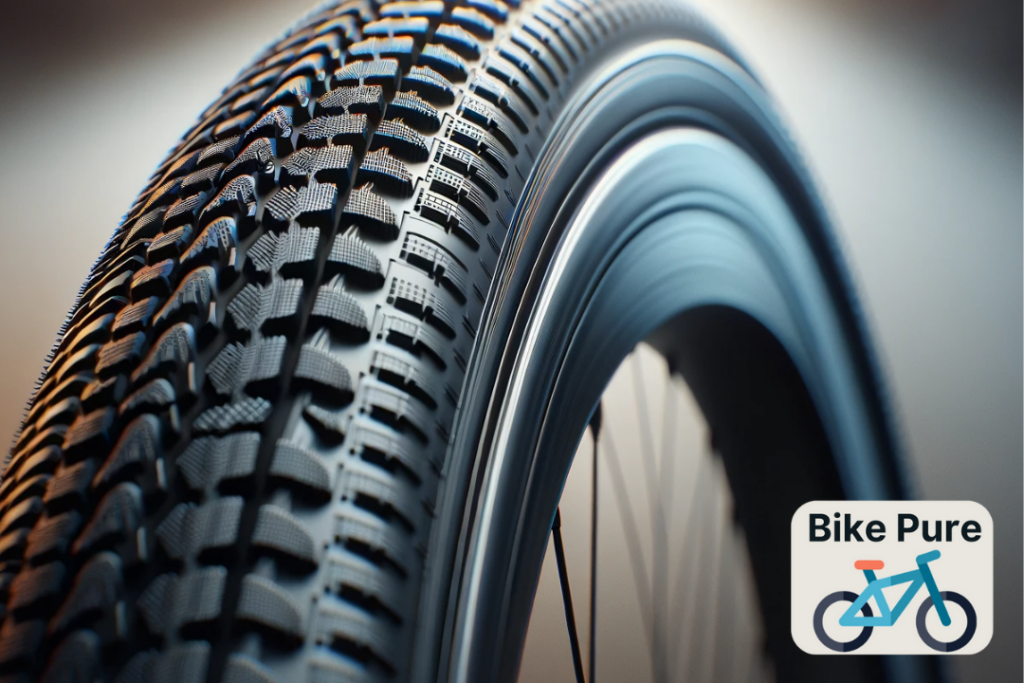
Bike tires consist of three main parts: the casing, the bead, and the tread. The casing is the foundation of the tire, providing the structure and supporting the rider’s weight.
The bead is a stiff wire that holds the tire securely onto the rim, preventing it from slipping during use. The tread is the outer surface of the tire, which comes into contact with the road or trail, providing grip and protection against punctures.
There are different types of bike tires, such as clincher, tubular, and tubeless.
Clincher tires use an inner tube to hold air pressure, while tubular tires have a tube sewn inside the casing.
Tubeless tires, on the other hand, don’t require an inner tube and are usually filled with a liquid sealant that helps prevent punctures.
Importance of Understanding Tire Basics in Preventing Punctures
Understanding the basics of bike tires is needed in preventing punctures. Knowing the components of a tire and the differences between various types of tires will help you make informed decisions when selecting and maintaining your tires.
Regular tire maintenance is required in preventing punctures. Ensure your tires are inflated to the recommended pressure, as underinflated tires are more prone to punctures and can cause uneven wear.
Check the tread for any debris, such as glass or thorns, which could cause a puncture. Removing these objects regularly will help in avoiding potential punctures.
Investing in high-quality tires with puncture-resistant features, such as kevlar lining or a higher thread count in the casing, can help reduce the likelihood of punctures.
Some riders opt for tubeless tires, as they rely on a sealant that can quickly fill small punctures, allowing the rider to continue their journey without stopping to fix a flat tire.
Importance of Tire Pressure
The Role of Correct Tire Pressure in Preventing Punctures
Maintaining the correct tire pressure is important for preventing bike tire punctures. When the pressure is optimal, it evenly distributes the tire’s contact with the road surface, reducing the likelihood of sharp objects penetrating the tire.
The right tire pressure also helps enhance the overall performance, comfort, and safety of the bike. Ensuring your tires are properly inflated can minimize the chances of encountering tire punctures on your rides.
Risks of Over-Inflation and Under-Inflation
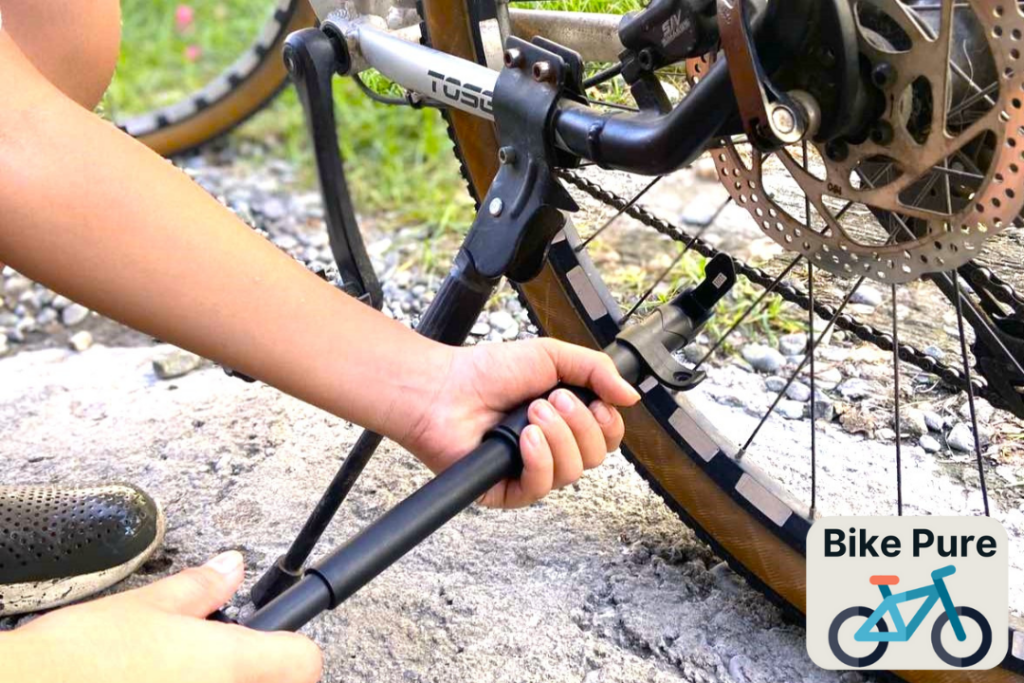
Both over-inflation and under-inflation pose risks to your bike tires.
Over-inflated tires have a reduced contact patch with the road, resulting in diminished traction and control. They are also more susceptible to punctures, as the increased pressure makes the tire more rigid and prone to damage from sharp objects.
Under-inflated tires, on the other hand, have increased rolling resistance, making cycling more labor-intensive. These tires are also at higher risk of pinch flats, as the lack of proper pressure allows the rim to compress the tire and inner tube against the ground, potentially causing punctures.
How to Check and Maintain The Right Pressure
To maintain the right tire pressure, always keep in mind to regularly check your bike’s tires. Most bike tires have a recommended pressure range, measured in psi (pounds per square inch), imprinted on the sidewall of the tire. It’s extremely important to stay within this range for optimal performance and puncture prevention.
To check tire pressure, use a reliable tire pressure gauge or a pump with an integrated gauge. Connect the gauge to the tire valve and read the pressure.
If it’s outside the recommended range, inflate the tire to the desired pressure using a bike pump. It’s good practice to check your tire pressure before each ride or at least once a week, making adjustments as necessary.
By understanding the importance of tire pressure and taking steps to maintain it properly, you can significantly reduce the risk of bike tire punctures and enjoy a safer, more comfortable riding experience.
Choosing the Right Tire
Discussion on Tire Quality and Materials
When selecting a tire for your bike, always keep in mind the quality of the materials used in the tire’s construction. High-quality bike tires are made from durable materials like synthetic rubber and nylon, which offer excellent puncture resistance.
These materials help prevent punctures by distributing impact forces more evenly across the tire, reducing the chance of sharp objects penetrating the tire’s surface.
The use of high-quality materials in a bike tire’s construction results in better performance and a longer lifespan, making them a wise investment for cycling enthusiasts.
Introduction to Puncture-Resistant Tires and Their Advantages
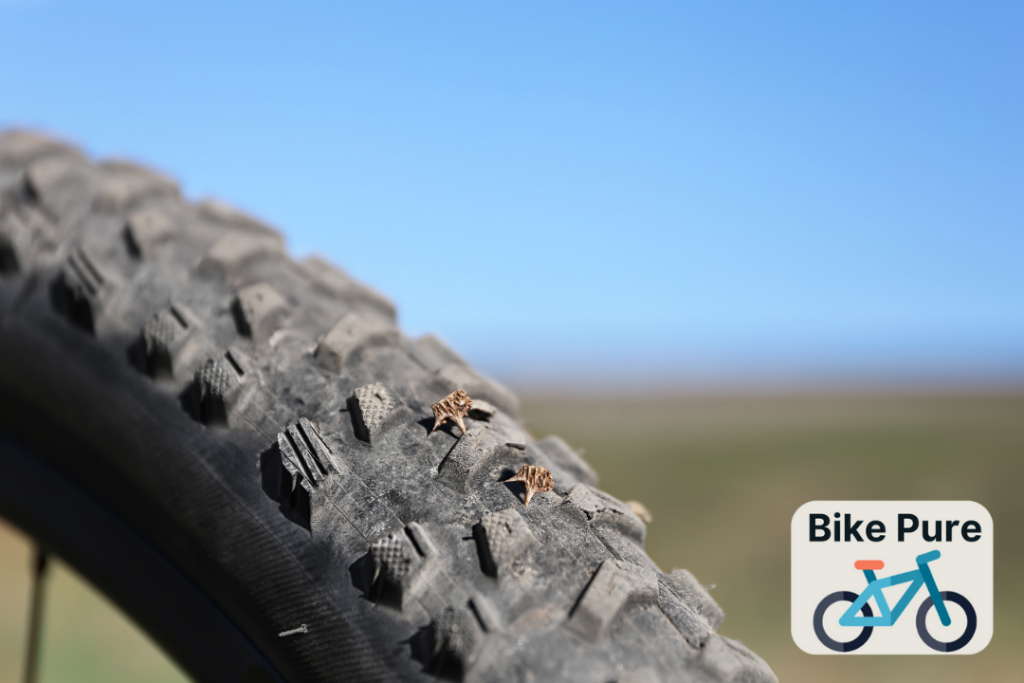
Puncture-resistant tires are designed specifically to help prevent punctures and increase a tire’s durability. These types of tires often come with additional layers of puncture protection, such as a puncture protection belt or a built-in sealant that will automatically seal small punctures.
The advantages of using puncture-resistant tires on your bike are numerous. First, they reduce the likelihood of experiencing a puncture while riding, thus increasing your safety and confidence on the road. Puncture-resistant tires can save you time and money by reducing the need for frequent inner tube replacements due to punctures.
The Role of Tire Tread in Puncture Prevention
The tread pattern on a bike tire plays a pivotal role in puncture prevention. A tire with a more aggressive tread pattern will provide better grip and traction on various surfaces, which can help reduce the risk of punctures.
The increased contact area between the tire and the road surface can distribute the impact forces over a larger area, making it more difficult for sharp objects to penetrate the tire’s surface.
When selecting a tire for your bike, it is recommended to choose a tread pattern that is suitable for the type of terrain you plan to ride on. For example, smooth road tires are recommended for city cyclists who mainly travel on well-maintained roads, while knobbier mountain bike tires are better suited for off-road and rough terrain.
To sum up, selecting the right tire for your bike is a significant factor in preventing punctures. Consider the quality of the materials, the benefits of puncture-resistant tires, and the role of tire tread when choosing the best tire for your needs.
Tire Liners: An Added Layer of Protection
What are Tire Liners and How They Work
Tire liners are an additional layer of protection to prevent bike tire punctures. They are specifically designed to be inserted between the inner tube and the tire to act as a shield against sharp objects, such as glass, nails, or thorns that could cause punctures.
Tire liners can be made of various materials like polyurethane, plastic, or rubber, and they are designed to retain their shape and durability under the constant pressure and stress exerted by the bike wheel.
These protective layers work by creating a barrier between the potential puncture-causing objects and the inner tube.
When a sharp object tries to penetrate the tire, the tire liner distributes the force across a larger area, reducing the likelihood of a puncture in the inner tube. This protection helps to extend the lifespan of your tires and reduce the frequency of punctures, making your ride more secure and enjoyable.
Benefits of Using Tire Liners
There are several advantages to using tire liners as a method of puncture protection for your bike’s tires. Some key benefits include:
- Puncture protection: As mentioned earlier, tire liners provide an added layer of defense against sharp objects that could cause punctures, ultimately preserving the inner tube and reducing the risk of a flat tire.
- Extended tire life: By shielding your tires from potential damage, tire liners can extend the life of your tires, decreasing the need for frequent tire replacements.
- Peace of mind: Knowing that your tires are equipped with an additional layer of protection provides a sense of security, allowing you to focus on the ride without constantly worrying about potential punctures.
- Cost-effectiveness: Investing in tire liners can save you money in the long run by reducing the frequency of punctures and the need for tire replacement or repair.
Puncture-Resistant Tubes
Description of These Special Tubes
Puncture-resistant tubes are a type of inner tube designed to provide extra protection against punctures and flats for your bicycle tires.
They are typically made from thicker materials or incorporate additional layers of puncture protection compared to regular tubes. Puncture-resistant tubes are a popular choice for cyclists who frequently ride in areas with a high risk of punctures, such as urban environments or off-road trails.
How They Differ from Regular Tubes
Puncture-resistant tubes differ from regular tubes in a few key ways:
- Material: These tubes are often made from thicker rubber or incorporate a puncture-resistant layer, which helps prevent sharp objects from penetrating the tube and causing a flat tire.
- Design: Some puncture-resistant tubes have a built-in barrier, such as a Kevlar belt, to add extra protection against punctures.
- Weight: Due to the added materials and layers, puncture-resistant tubes can be slightly heavier than standard tubes.
Benefits of Using Puncture-Resistant Tubes
Using puncture-resistant tubes in your bicycle tires offers some significant benefits:
- Fewer flats: The primary benefit of these tubes is the reduction in flat tires caused by punctures, resulting in less time spent on the side of the road fixing flats and more time enjoying your ride.
- Increased durability: The added layers of puncture protection also make these tubes more durable. As a result, they can last longer than regular tubes.
- Improved confidence: Knowing that your bike tires are less prone to punctures can increase your confidence while cycling and allow you to ride in a wider range of environments without worrying about flats.
To sum up, puncture-resistant tubes are a valuable investment for cyclists looking to prevent bike tire punctures and enhance their cycling experience. By understanding the differences between these tubes and regular tubes, as well as the benefits they offer, you can make an informed decision when choosing the best inner tubes for your bike.
The Magic of Tire Sealants
Explanation of What Tire Sealants Are
Tire sealants are specially designed liquid formulations that help to prevent bike tire punctures. These sealants are usually poured into the inner tube of the tire, creating a protective barrier. Their primary purpose is to rapidly seal any punctures that may occur when riding, thus preventing air loss and maintaining tire pressure.
Sealants are becoming increasingly popular among cyclists due to their effectiveness in reducing the chances of getting a flat tire.
How They Work in Sealing Punctures
When a puncture occurs in a tire with sealant, the liquid quickly flows towards the puncture site, thanks to the pressure and air movement inside the inner tube.
Once the sealant reaches the puncture, it forms a temporary plug, stopping the air leakage and allowing the rider to continue without significant loss of air pressure. This process occurs within seconds, effectively minimizing the impact of the puncture.
Common ingredients in tire sealants include:
- Latex-based compounds: These materials offer strong adhesion and flexibility, ensuring a rapid and effective seal.
- Fibers or particles: Added to the sealant to help reinforce the plug formed at the puncture site, thereby increasing the overall seal strength.
Pros and Cons of Using Sealants
Pros:
- Puncture prevention: Tire sealants significantly reduce the likelihood of getting a flat tire due to a puncture, ensuring a more enjoyable and hassle-free cycling experience.
- Convenience: With tire sealants, you don’t have to worry about frequent tire patching or replacement, as the sealant will take care of small punctures automatically.
- Versatility: Sealants are suitable for various types of tires and inner tubes, making them a practical option for many cyclists.
Cons:
- Not a permanent solution: While tire sealants are effective in sealing small punctures, they may not be able to seal larger ones. Therefore, it’s important to properly inspect your bike tire regularly.
- Potential mess: Sealants can be messy to work with, especially when initially installing or removing them from the tire.
- Weight addition: Some riders may be concerned about the additional weight added to the tire by the sealant. The benefits of puncture protection often outweigh this minor concern.
Regular Inspection and Maintenance
The Importance of Periodic Tire Checks
Regular inspection and maintenance are necessary in preventing bike tire punctures. By periodically checking the condition of your bike tires, you can detect and address signs of wear before they lead to punctures.
Old tires are more susceptible to debris and sharp objects on the road, which may cause punctures. Establish a routine for inspecting your bike tires to ensure their longevity and your safety on the road.
Identifying and Removing Potential Threats Like Glass Shards and Thorns
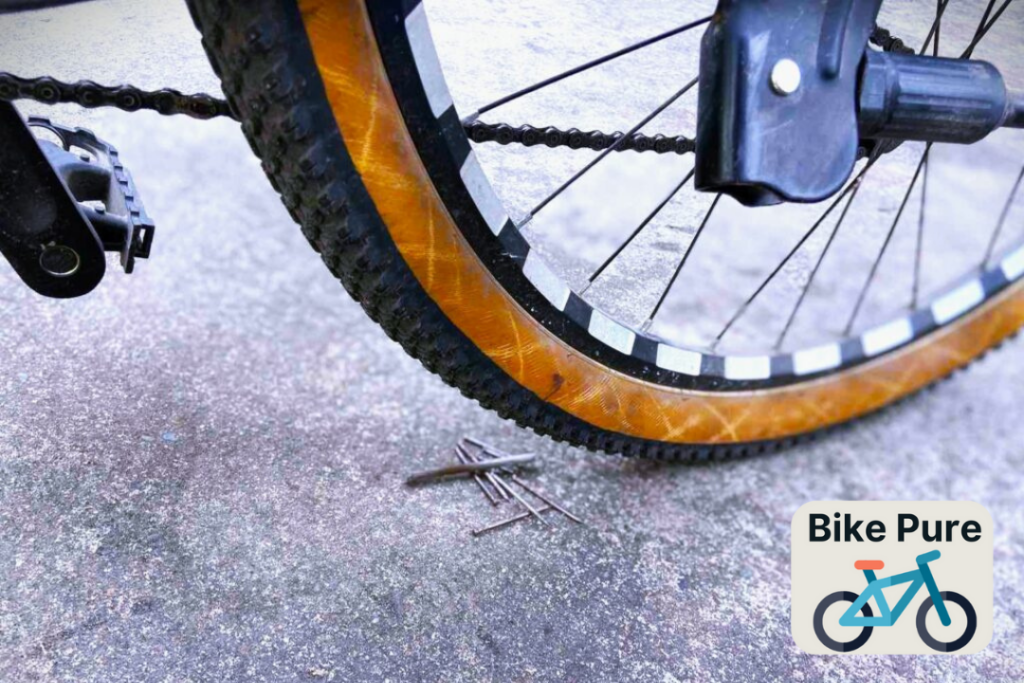
Riding through debris on the road increases the risk of punctures. Glass shards, thorns, and other sharp objects can easily embed into your bike tires, eventually causing a puncture. To minimize this risk, inspect your bike tires after each ride or periodically, depending on how often you ride.
Carefully remove any embedded debris, and monitor the condition of the tire for signs of wear or damage. It’s also important to keep an eye out for debris while riding and avoid it whenever possible.
Tips for Effective Inspection
Here are some guidelines to help with your tire inspection process:
- Tire pressure: Before every ride, check the bike’s tire pressure. Ensure your tires are inflated to the manufacturer’s recommended pressure levels. Overinflated or underinflated tires can increase the risk of punctures.
- Visual inspection: Check for any noticeable cuts, abrasions, or bulges on the tire’s surface. These can indicate potential weak spots, increasing the likelihood of a puncture.
- Tread depth: Inspect the tire’s tread depth to ensure it’s still within safe limits. Tires with shallow tread are more prone to punctures.
- Rotation: Rotate your tires according to the manufacturer’s recommendations. Consistent rotation helps promote even wear and extends the lifespan of your tires.
Implementing these best practices for tire inspection and maintenance can help you prevent bike tire punctures and improve your overall cycling experience.
Adopting Proper Riding Techniques
Tips on Avoiding Common Puncture-Causing Obstacles
Cyclists can prevent bike tire punctures by being aware of their surroundings and taking measures to avoid common puncture-causing obstacles. It is important to always scan the path ahead and be prepared to adjust the route if necessary. Some common obstacles that can cause tire punctures include:
- Glass shards
- Nails and screws
- Sharp rocks
- Metal debris
Remember to keep a safe distance from the roadside edge or gutter, as these areas often accumulate debris that can lead to punctures.
The Importance of Lifting The Front Wheel Over Sharp Objects
Sometimes cyclists may encounter sharp objects that they cannot avoid. In these instances, it is important to know how to properly lift the front wheel over the obstacle to prevent tire damage. To do this, riders should:
- Shift the body weight towards the back of the bike.
- Lightly pull up on the handlebars while simultaneously applying pressure to the pedals.
- Quickly release the handlebars as the front wheel clears the obstacle and comes back down.
Practicing this technique regularly will help cyclists protect their tires and prevent punctures caused by sharp objects.
Choosing The Best Paths and Lanes for Cycling
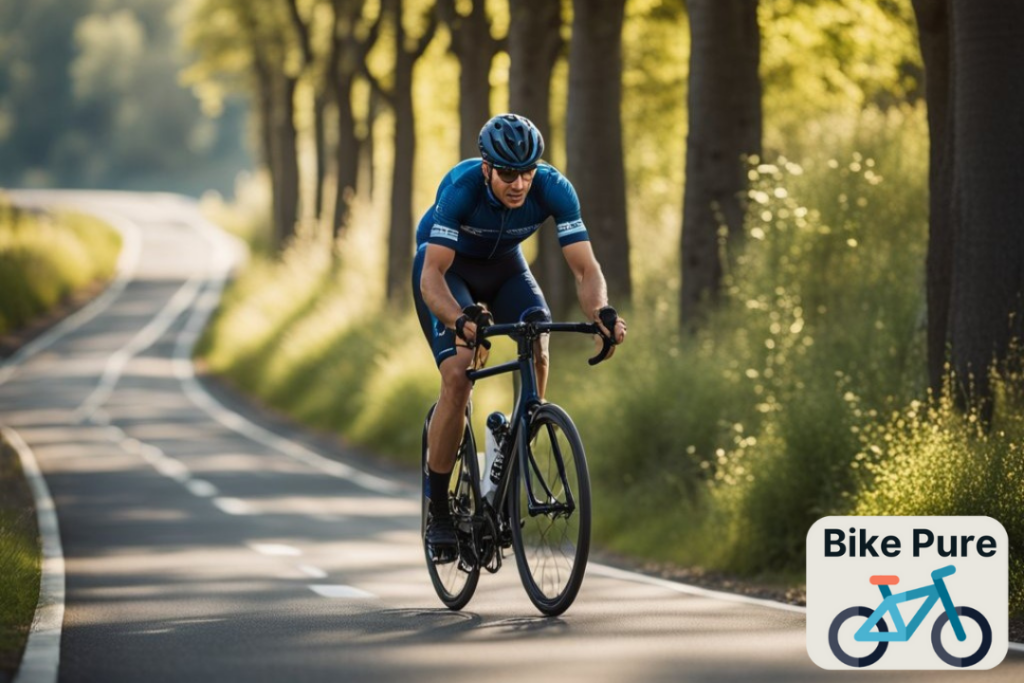
Avoiding areas with a high concentration of debris and choosing the best paths and lanes for cycling is essential for preventing bike tire punctures. Cyclists should:
- Opt for paved, well-maintained bike paths or roads when possible.
- Check local cycling forums or apps for information on routes with fewer obstacles and hazards.
- Avoid cycling through construction zones or areas known for a high amount of debris.
By adopting proper riding techniques, such as avoiding puncture-causing obstacles, lifting the front wheel over sharp objects, and choosing the best paths and lanes for cycling, cyclists can significantly reduce the risk of tire punctures and improve their overall riding experience.
Understanding Wheel and Tire Size
The Advantages of Wider Tires in Puncture Prevention
Wider tires have certain advantages when it comes to puncture prevention. They typically offer a larger contact area and run at a lower pressure, which helps provide cushioning and reduces the likelihood of puncturing on rough surfaces.
The lower pressure allows wider tires to deform around sharp objects like glass, thorns, or stones, as opposed to having them penetrate the tire. Wider tires are also beneficial in distributing the rider’s weight over a larger surface area, which means less stress on the tire and less chance of a puncture occurring.
Wider tires can also help provide better grip, especially on uneven or loose surfaces. This is particularly useful for off-road biking where the terrain can be challenging. Improved traction can help prevent punctures by allowing the rider to maintain better control over the bike and reduce the risk of hitting sharp objects at high speeds.
How Tire Size Affects Puncture Vulnerability
Tire size plays an important role in determining the vulnerability of a bike tire to punctures. A smaller tire with a narrower width will have a higher pressure, which can make it more susceptible to punctures.
A larger tire will have a lower pressure, reducing the risk of punctures by allowing the tire to deform around potential puncture-causing objects. A wider tire can provide greater cushioning, further reducing the likelihood of a puncture.
Here are some factors to consider when choosing a tire size:
- Bike type: The type of bike you are riding can influence the optimal tire size for puncture prevention. Mountain bikes often use larger and wider tires due to the rough terrain they’re designed for. Road bikes typically have narrower tires for reduced rolling resistance and higher speeds.
- Rider weight: Keep in mind to take the rider’s weight into account when determining the most suitable tire size. A heavier rider may benefit from a larger tire that provides better weight distribution and puncture resistance.
- Terrain: The terrain you typically ride on will also play a part in determining the ideal tire size. Rough terrain with sharp rocks or debris is more likely to cause punctures. In such cases, a wider tire with lower pressure is recommended to provide better cushioning and protection against punctures.
| Tire Size | Pressure Level | Puncture Vulnerability |
| Small/Narrow | High Pressure | More susceptible to punctures |
| Large/Wide | Low Pressure | Less susceptible to punctures |
| Medium | Moderate Pressure | Balanced vulnerability |
Proper Bike Storage
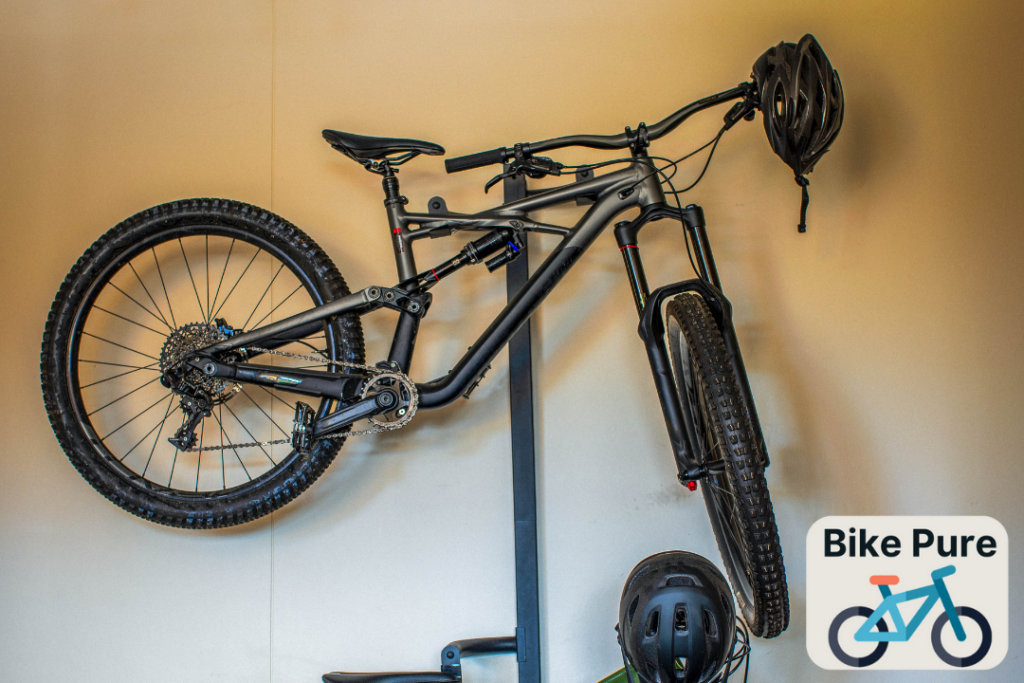
Tips for Storing Bikes to Prevent Tire Damage
Proper bike storage plays a big role in preventing tire punctures and prolonging the life of your bike. Here are some helpful tips to keep in mind:
- Keep bikes off the ground: Hanging your bike or using a bike stand not only saves space but also prevents direct contact with the ground, which can cause pressure on the tires and increase the risk of punctures.
- Avoid overcrowded areas: Storing your bike in congested areas may result in accidental damage to the tires, as well as other parts of the bike. Allocate a dedicated storage space to reduce the risk of damage.
- Maintain optimal tire pressure: Regularly check and maintain the recommended tire pressure to prevent undue stress on the tire sidewalls. Under-inflated tires are at a higher risk of punctures and damage.
- Use puncture-resistant accessories: Consider using puncture-resistant tires, puncture sealants, or latex liners to reduce the risk of punctures while the bike is in storage.
The Effects of UV Rays on Tire Longevity
UV rays from the sun can have detrimental effects on the longevity and performance of bike tires. Over time, sun exposure can cause the rubber on a tire to become brittle, which increases the likelihood of punctures. To prevent this issue:
- Store bikes indoors: Whenever possible, store your bike in a garage or a dedicated storage room with limited exposure to direct sunlight. Doing so can help protect your tire rubber from UV damage.
- Use a bike cover: If indoor storage is not an option, using a heavy-duty, UV-resistant bike cover is a good alternative. Make sure the cover fits snugly and securely to offer effective protection against the sun.
- Rotate bikes in storage: If multiple bikes are stored together, periodically rotating their positions can help ensure that each bike’s tires are exposed to similar levels of UV radiation, reducing overall risk.
By following these guidelines and proper bike storage methods, you can significantly reduce the risk of tire punctures and ensure the longevity of your bike’s tires.
The Practice of Rotating Tires
Keeping your bike’s tires in good condition is needed for preventing punctures. One effective method to achieve this goal is by rotating your tires. This section will discuss how rotating tires can lead to even wear and the frequency and methods of tire rotation.
How Rotating Tires Can Lead to Even Wear
Rotating your bike’s tires ensures that they wear evenly, which in turn reduces the chances of punctures or other issues due to uneven wear. As a cyclist, you’ll likely notice that the front and rear tires wear differently, depending on factors such as your weight distribution and riding style.
By regularly rotating your tires, you can help to balance out this wear and prolong the life of your tires. Furthermore, this practice can contribute to improved ride quality and performance.
Frequency and Methods of Tire Rotation
The frequency of tire rotation depends on how often you ride your bike and the type of riding you do. In general, it’s a good idea to rotate your tires every 2,000-3,000 miles or when you observe an uneven wear pattern that may lead to punctures. It’s worth noting that some tire manufacturers may provide specific recommendations for rotation frequency, so it’s best to consult the documentation provided with your tires.
When it comes to methods of tire rotation, here are some guidelines to follow:
- Front-to-rear rotation: The most common method is to swap the positions of the front and rear tires. Simply dismount your tires and remount them in the opposite positions. This method helps to equalize wear, especially for road bikes.
- X-pattern rotation: This method is more relevant for bikes with wheels of the same size and tires that are not directional. It involves swapping the front and rear tires, as well as moving the left tire to the right side and vice versa. This ensures a more even wear across both tires.
In short, rotating your bike’s tires can be an effective way to prevent punctures by ensuring even wear. Make sure to rotate them regularly and follow the recommended methods for the best results.
The Value of Training and Workshops
Taking preventative measures to avoid bike tire punctures is necessary for cyclists, especially those using their bikes for commuting and long road bike journeys. One effective way to learn and enhance maintenance skills is by attending training sessions and workshops focused on bike tire care.
Benefits of Attending Tire Maintenance Workshops
Attending tire maintenance workshops provides numerous advantages for bike owners. These sessions offer hands-on experience in handling tire issues and their repercussions, such as road hazards and accidents.
Participants can learn effective techniques to properly inflate tires, maintain tire pressure, and inspect for damage. They also acquire knowledge about the importance of using high-quality puncture-resistant tires, which significantly reduce the likelihood of experiencing punctures.
Workshops also provide valuable information about factors that contribute to puncture risk, like road conditions and debris, helping cyclists identify and avoid potential hazards. Furthermore, attendees can gain insights into essential bike maintenance tools, such as tire levers, patch kits, and portable pumps, which can come in handy in dealing with tire issues during commutes or road bike trips.
Where to Find Relevant Training Sessions
To find relevant bike tire maintenance training sessions, cyclists can consider the following sources:
- Local bike shops: Many local bike shops offer workshops and training sessions on bike maintenance, including tire care. They generally have well-trained and knowledgeable staff who can provide valuable hands-on guidance.
- Cycling clubs and groups: Joining a cycling club or group in the area allows members to share their expertise and learn from experienced cyclists. Some clubs may even organize maintenance workshops for members, which can cover various aspects of tire care.
- Community centers and educational institutions: Local community centers and educational institutions like universities, colleges, or adult education centers often offer workshops and training sessions on bike maintenance. Enrolling in these classes can help cyclists enhance their bike care skills, including tire maintenance.
- Online resources: In today’s digital age, numerous online resources, such as video tutorials, articles, and webinars, are available for cyclists looking to learn about tire care. Websites like YouTube and cycling blogs provide valuable information that can be accessed at any time.
Recommendations for Puncture-Resistant Tires and Sealants
Being well-equipped with the right tires and sealants can also help prevent punctures. Here are some recommendations for puncture-resistant tires and sealants:
Puncture-Resistant Tires
- Continental Gatorskin: A popular choice among cyclists, these tires have a durable and puncture-resistant casing that provides excellent protection against flats.
- Schwalbe Marathon Plus: Designed for long-distance touring, these tires feature a robust and puncture-proof layer called SmartGuard.
Tire Sealants
Using a sealant in your bike’s inner tube or tubeless system can help prevent punctures from turning into flats. Here are two popular sealants to consider:
- Stans NoTubes: This sealant is widely used by cyclists for its effectiveness in sealing punctures. It can be used with both tubes and tubeless systems.
- Orange Seal: Another popular option, Orange Seal is known for its long-lasting and quick-sealing properties.
By following the advice in these resources and selecting high-quality tires and sealants, you can minimize the chance of experiencing bike tire punctures and enjoy a worry-free ride.
Frequently Asked Questions
What are the best puncture-resistant tires for various types of bikes?
Puncture-resistant tires offer additional protection against sharp objects and road debris. Typically, these tires have thicker and more robust materials built into the tread and sidewall. Some popular puncture-resistant tires include the Schwalbe Marathon Plus for urban and touring bikes, Continental Gatorskin for road bikes, and Maxxis CrossMark for mountain bikes.
Always keep in mind to choose a tire suitable for your specific type of bike and riding conditions. For specific recommendations on puncture-resistant tires for different bike types, you might find our articles on best road bike tires, best mountain bike tires, and best gravel bike tires useful.
How effective are tire liners in preventing punctures?
Tire liners are an additional layer of protection placed between the tire and the inner tube. They can be quite effective in preventing punctures caused by thorns, glass, or other sharp objects. Some riders prefer to use tire liners in combination with puncture-resistant tires for added protection. Tire liners may increase rolling resistance and add a small amount of weight to the wheel.
Are tubeless bike tires less prone to punctures?
Tubeless tires eliminate the need for an inner tube, thereby reducing the possibility of pinch flats. They also offer better puncture resistance since the sealant within the tire can quickly seal small punctures. Tubeless tires are not entirely immune to punctures, and larger punctures or tears in the tire casing may still require repair.
Do puncture prevention fluids actually work?
Puncture prevention fluids, also known as tire sealants, work by sealing small punctures as they occur. When a puncture happens, the fluid’s pressure forces it into the hole, sealing the tire and helping maintain air pressure. These fluids are often used in tubeless tires but can also be added to inner tubes. While they can be effective for small punctures, sealants may struggle with larger punctures or cuts in the tire.
What tips can help avoid punctures on frequently punctured routes?
To avoid punctures on routes prone to debris or sharp objects, consider the following tips:
- Maintain proper tire pressure: Underinflated tires are more susceptible to punctures, while overinflated tires can cause a harsh and uncomfortable ride.
- Use puncture-resistant tires or tire liners.
- Regularly inspect your tires for cuts, embedded debris, or wear.
- Avoid riding through glass, debris, or other potential hazards.
- Change your route if possible to avoid problematic areas.
How can I maintain my bike tires for increased puncture resistance?
Maintaining your bike tires for increased puncture resistance involves:
- Regularly checking tire pressure and keeping them inflated according to the manufacturer’s recommendations.
- Inspecting your tires for cuts, embedded debris, or signs of wear.
- Cleaning your tires after rides, especially if you have encountered mud, debris, or other potential hazards.
- Replacing worn-out tires promptly.
- Considering the use of puncture-resistant tires, tire liners, or sealants for added protection.
